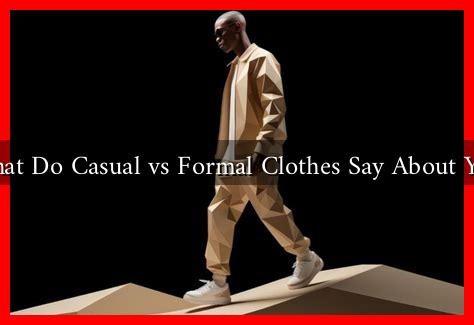-
Table of Contents
What Do Casual vs Formal Clothes Say About You?
Clothing is more than just a means of protection against the elements; it is a powerful form of self-expression. The way we dress can convey a multitude of messages about our personality, social status, and even our professional aspirations. In this article, we will explore the differences between casual and formal clothing, what they signify about the wearer, and how they can impact perceptions in various social and professional settings.
The Essence of Casual Clothing
Casual clothing is often associated with comfort, relaxation, and a laid-back attitude. It includes items such as jeans, t-shirts, sneakers, and casual dresses. The primary message conveyed by casual attire is one of approachability and ease.
Characteristics of Casual Wear
- Comfort: Casual clothes are designed for comfort, allowing for ease of movement and a relaxed fit.
- Versatility: Casual wear can be easily mixed and matched, making it suitable for various occasions.
- Personal Expression: Casual clothing often reflects personal style, interests, and creativity.
For example, a person wearing a graphic t-shirt featuring their favorite band may be perceived as approachable and relatable, while someone in athleisure might be seen as health-conscious and active. According to a study by the Journal of Experimental Social Psychology, people often make quick judgments about others based on their clothing, with casual attire typically signaling friendliness and openness.
The Significance of Formal Clothing
In contrast, formal clothing is often associated with professionalism, authority, and respect. This category includes suits, ties, formal dresses, and polished shoes. The message conveyed by formal attire is one of seriousness and commitment.
Characteristics of Formal Wear
- Professionalism: Formal clothing is often required in business settings, signaling that the wearer takes their role seriously.
- Attention to Detail: The choice of formal attire often reflects a meticulous approach to personal presentation.
- Social Status: Formal wear can indicate a certain level of social standing or success.
For instance, a well-tailored suit can project confidence and authority, making the wearer appear more competent in a business meeting. A study published in the journal Psychology of Dress found that individuals dressed in formal attire were perceived as more capable and intelligent compared to those in casual clothing.
Casual vs. Formal: The Impact on Perception
The choice between casual and formal clothing can significantly influence how others perceive you. Here are some key points to consider:
- First Impressions: People often form first impressions within seconds, and clothing plays a crucial role in this process.
- Social Context: The appropriateness of casual or formal attire can vary depending on the social setting, such as a wedding versus a casual get-together.
- Career Advancement: In professional environments, dressing formally can enhance opportunities for career advancement and networking.
For example, a study by the University of California found that individuals who dressed more formally were more likely to be hired for jobs compared to those in casual attire, highlighting the importance of dressing appropriately for the occasion.
Conclusion: Dressing for Success
In conclusion, the clothing we choose to wear—whether casual or formal—speaks volumes about our personality, values, and aspirations. Casual attire often conveys a sense of approachability and creativity, while formal clothing signals professionalism and authority. Understanding the implications of our clothing choices can empower us to make informed decisions that align with our personal and professional goals. Ultimately, dressing appropriately for the occasion can enhance our interactions and open doors to new opportunities.

